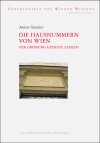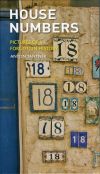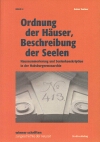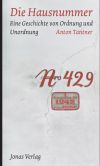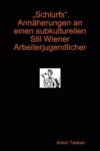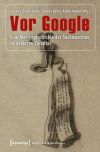Sehr schön, soeben ist die von Reuben Rose-Redwood und mir herausgegebene Hausnummern-Sektion der aktuellen Ausgabe von Urban History erschienen. Gemäß dem Vertrag mit Cambridge University Press können die Autoren ihre Artikel unmittelbar nach Erscheinen auf ihrer persönlichen Homepage zur Verfügung stellen und nach einem Jahr dann in die Institutional Repositories ihrer Universitäten einstellen.
Die von Reuben Rose-Redwood und von mir verfasste Einleitung kann ich somit sofort Open Access zur Verfügung stellen, und wir werden die anderen Autoren bitten, dies ebenfalls zu tun.
Update: Die Artikel sind wie es scheint frei und ohne VPN-Umweg über eine Bibliothek zugänglich, ich habe dies ganz übersehen!
Urban History - Volume 39 - Issue 04 - November 2012
https://journals.cambridge.org/action/displayIssue?jid=UHY&volumeId=39&issueId=04&seriesId=0
History of Urban House Numbering
Rose-Redwood, Reuben/Tantner, Anton: Introduction: governmentality, house numbering and the spatial history of the modern city, in: Urban History, 39.2012/4, S. 607-613.
DOI:
https://dx.doi.org/10.1017/S0963926812000405
Self-Archive:
https://tantner.net/publikationen/Rose-RedwoodTantner_HouseNumbering_UrbanHistory_2012-4.pdf
Abstract: This special section of Urban History explores the spatial histories of urban house numbering and the calculative rationalities of government since the Enlightenment. More than a mere footnote to the history of postal communications, the house number was first introduced as an inscriptive device to serve a wide range of governmental purposes, from military conscription and the quartering of soldiers to census-taking and the policing of urban populations. The spatial practice of house numbering can therefore be seen as a ‘political technology’ that was developed to reorganize urban space according to the dictates of numerical calculation. The articles in this special section examine the historical emergence of house numbering, and related practices, in different geographical circumstances, illustrating the spatial strategies of governmentality and the tactics of resistance that shaped the spatial organization of the modern city.
Cicchini, Marco: A new ‘inquisition’? Police reform, urban transparency and house numbering in eighteenth-century Geneva, in: Urban History, 39.2012/4, S. 614-623.
DOI:
https://dx.doi.org/10.1017/S0963926812000417
Abstract: As an administrative tool of police reform, the introduction of house numbering in eighteenth-century Geneva was the result of a broad desire for urban transparency that resulted in the production of a new ‘regime of visibility’. This article examines how the logic of ‘number’ transformed the way in which urban space was conceived, organized and governed. As a political technology, the spatial practice of house numbering enabled governmental officials to divide, count, identify and classify urban populations in order to regulate the spaces of circulation in the modern city. Although the city's house-numbering system is taken for granted by most of the town-dwellers today, the current study illustrates how these police techniques encountered considerable resistance when they were initially imposed during the latter half of the eighteenth century.
Rose-Redwood, Reuben: ‘A regular state of beautiful confusion’: governing by numbers and the contradictions of calculable space in New York City, in: Urban History, 39.2012/4, S. 624-638.
DOI:
https://dx.doi.org/10.1017/S0963926812000399
Abstract: Historical scholarship on the spatial organization of cities has largely ignored the crucial role that house numbering has played as a political technology of spatial calculation since the eighteenth century. This article examines the spatial history of house numbering in Manhattan to illustrate how the numbering of buildings was a key strategy employed to reconfigure the city as a space of calculability. From the very outset, however, such calculable spaces of ‘number’ were riddled with contradictions, resulting in several rounds of spatial rationalization over the course of the eighteenth and nineteenth centuries. More than a mere technical concern alone, the history of house numbering in New York City exemplifies the spatial politics and temporal instabilities that have shaped the spaces of calculation in the modern city.
Harris, Richard/Lewis, Robert: Numbers didn't count: the streets of colonial Bombay and Calcutta, in: Urban History, 39.2012/4, S. 639-658.
DOI:
https://dx.doi.org/10.1017/S0963926812000429
Abstract: Street and house numbers are part of the modern state's geo-locational regime, by which people and places are made legible to distant governments and bureaucrats. Some writers have suggested that they were important in colonial cities, where urban regulation and political control was often insecure, but we know little about their extent and significance in such settings. Bombay and Calcutta c.1901 are significant test cases, being two of the largest colonial cities in the world, as well as being recent sites of major disease outbreaks. City directories in Bombay, together with property assessment and census evidence for Calcutta, show that house numbers were rare for all types of property and people. Local residents used other methods to navigate the city, while British administrators did not believe house numbers to be an important aspect of colonial rule. Fragmentary evidence for other colonial cities suggests that the experience of these Indian cities was broadly typical.
Vuolteenaho, Jani: Numbering the streetscape: mapping the spatial history of numerical street names in Europe, in: Urban History, 39.2012/4, S. 659-679.
DOI:
https://dx.doi.org/10.1017/S0963926812000442
Abstract: In contrast to North American cities, numerically named streets are a very rare occurrence in Europe. This article explores the exceptions to this rule by charting the history of street numbering in 10 European countries. The medieval and early modern ‘new towns’ of New Winchelsea, Mannheim and a section of St Petersburg (Vasilievsky Island) were each designed with grid-plan layouts in which the streets were identified according to an alphanumerical system. Although a range of gridiron plans have been subsequently built across the continent, the newer instances of street numbering are characteristically inconspicuous and peripherally located in suburbs or industrial estates. As a result, most European cases of street numbering play a limited role in constituting the broader urban fabric of the streetscape, with the exception of cities such as Milton Keynes that conform more to the North American model. The relative absence of street-numbering plans in European cities can largely be explained by the much longer history of urbanism in Europe compared to North America and, above all else, the privileging of the nationalistic-pedagogic imperative to name streets with the aim of instilling historical ‘lessons’, which has left little room for the use of street numbering as a means of rationalizing the spatial organization of European cities.
adresscomptoir -
Hausnummerierung - Fr, 12. Okt. 2012, 09:32

